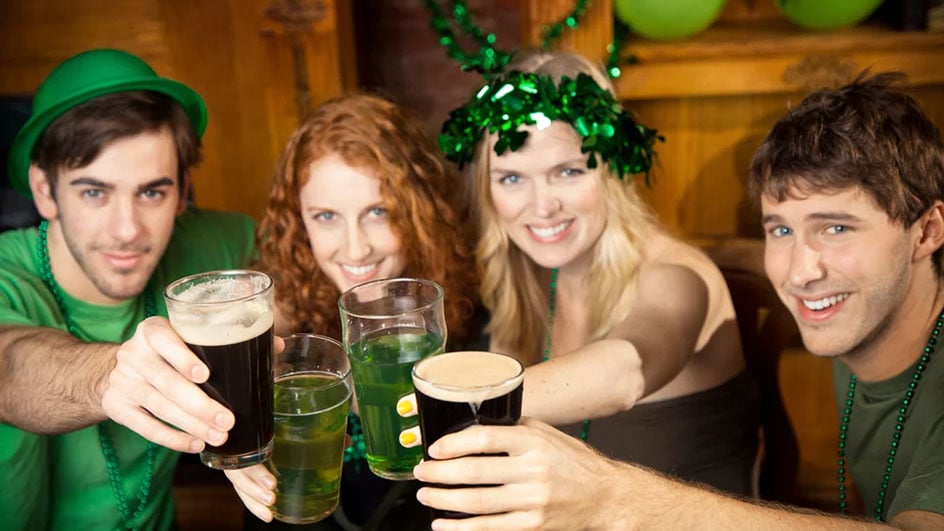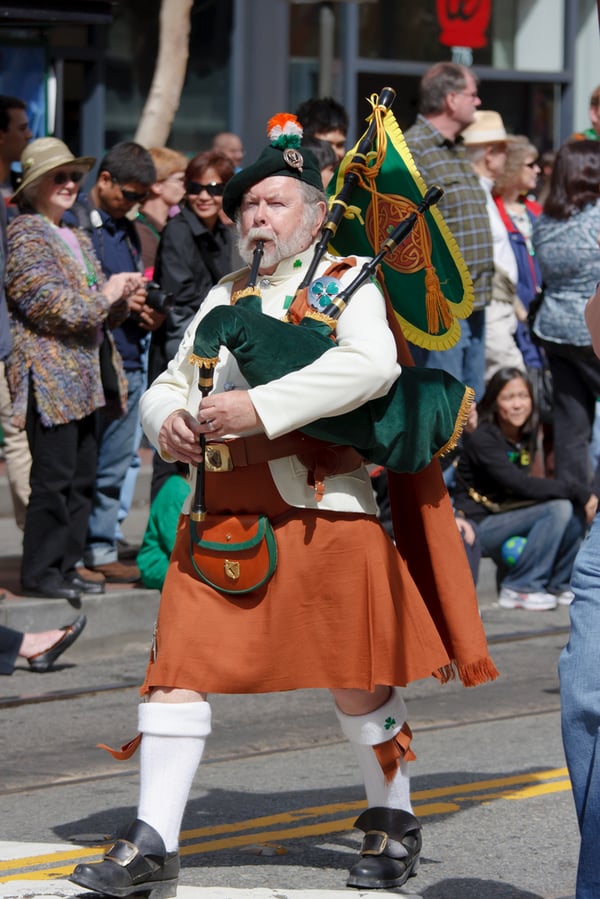How to Create the Perfect Royalty-Free Music Playlist for Your St. Patrick’s Day Celebration
Soundstripe Team
Soundstripe Team

Mar 12, 2019
Is that a Celtic harp and the proud beat of a bodhran drum you hear in the distance? Do your legs suddenly itch to dance a jig? That must mean St. Patrick’s Day is nearly upon us.
If you are planning a big St. Patrick’s Day bash, you’re going to need plenty of Guinness, pounds of tasty pork and cabbage, and, of course, lots of music!
No St. Patrick’s Day celebration is complete without an upbeat and fun St. Patrick’s Day music playlist. It doesn’t even need to be entirely composed of Irish music as long as it gets your guests singing and dancing.
However, if you plan on playing your music in a public spot, like at your pub or during a local parade, that music does need to be properly licensed!
Let’s talk music, licensing, and copyright law so you can make sure you keep everything above board for your celebration.
But first, if you’re going to put on a St. Patrick’s Day bash, you need to understand a thing or two about where this holiday comes from and what Irish music really is. Put all this information together, and you’ll learn how to create the perfect St. Patrick’s Day playlist.
If this party goes well, you may just earn some playful smooches. After all, on St. Patrick’s Day, we’re all Irish in spirit!
At its core, St. Patrick’s Day celebrates the life and death of Saint Patrick, the patron saint of Ireland. St. Patrick is believed to have brought Christianity to Ireland, where he preached until his death on March 17, 461.
How did such a solemn day become associated with drinking, big parades, and general carousing? It might have something to do with the date of the holiday. St. Patrick’s Day falls squarely in the middle of Lent, a time when the heavily Catholic Irish have traditionally given up their vices.
For over a thousand years, the Irish would attend church on the morning of St. Patrick’s Day and then celebrate in the evening. For this one day, the strictures of Lent were lifted, and the Irish could eat meat, drink, dance, and celebrate!
Ironically, it was the United States, not Ireland, who really put this holiday on the global map. On March 17, 1762, Irish soldiers serving in the English military held the very first St. Patrick’s Day parade in New York.
The middle of the 19th century brought a huge flow of poor Catholic Irish immigrants to the shores of the United States. Though they faced harsh conditions and discrimination, the Irish were intent on keeping their traditions alive. They continued to celebrate St. Patrick’s Day until the rest of the country got on board.
Fortunately, the United States has learned to appreciate its Irish heritage. These days, the Saint Patrick’s Day Parade in New York is the largest one in the country, usually involving 150,000 participants and attracting almost three million parade watchers.
We don’t expect your St. Patrick’s Day party will be quite that big, but it will still be a blast, especially if you put together a great Irish playlist!

As you begin to prepare your St. Patrick’s Day celebration, take a moment to appreciate the history of Irish music.
That doesn’t just mean listening to a Dropkick Murphys album while you drip green food coloring into the punch bowl, (though those guys are great). Let’s see where all those tin whistles and fiddling comes from.
The Irish have been creating beautiful and unique music for over 2,000 years. Irish music includes Eastern and Middle Eastern influences, but over the centuries it developed into something all its own.
For most of the island’s history, music was never written down. Instead, it was memorized by ear and re-imagined by each new successive generation. It was only in the 18th century when Irish music was finally captured on paper and preserved.
Since then, Ireland has exported its Celtic tunes as well as its top artists across the world. Over time, artists have mixed traditional Irish melodies and ballads with many different musical genres to create fascinating hybrids.
Popular Irish musicians and musical groups (like U2, Sinead O’Conner, and Enya) continue to spread Irish music around.
As you start planning your St. Patrick’s Day playlist, look for songs that include traditional Irish instruments, including the fiddle, Irish flute, tin whistle, Celtic harp, uilleann pipes, and bodhran drums.
But don’t stop there. Irish music has grown so much that you might be surprised by where you find Irish influences!
Of course, before you add any of your favorite Irish classics like “I’m Shipping Up to Boston” to your St. Patrick’s Day playlist, it’s important to understand what you can and can’t play at a public event.
At this point, it’s time to turn away from fun Irish history to look at not-so-fun copyright law.

Imagine sitting down at a fancy restaurant. As you wait for the server to take your drink orders, you enjoy the beautiful music playing over the speakers. Guess what? The restaurant almost certainly paid for a license so that they could play that music for you.
The same is true of the music in the grocery store and even that spicy Latin music that your Rumba instructor blasts.
Any organization that broadcasts music publicly must have what is known as a public performance license, or they must play royalty-free music. If you are hosting a public St. Patty’s Day celebration, you’ll need to brush up on your copyright law!
And before we go any further — no, your monthly subscription to Spotify or Pandora does not give you permission to play their Irish music channel during your public St. Patrick’s Day event!
If you play music at a public venue without a license, you are breaking the law. Specifically, you are breaking copyright law, which is designed to ensure the owners of the music in your playlist are fairly compensated for that song’s use.
You can certainly invest in a public performance license in order to keep on the right side of the law through organizations like:
However, these licenses aren’t cheap, and if you don’t regularly host public events, they probably aren’t worth the investment. Another option is to seek out royalty free music. There are a number of places where you can find royalty free music.
Spotify offers a copyright free catalog, and YouTube provides a free stock music library as well. If you don’t mind getting down with the oldies, you can also search for songs that have “aged out” of copyright protections and are now in the public domain.
One final option is to use a stock music site, like Soundstripe, to get your Irish groove on during St. Patrick’s Day.
The beauty of a stock music site like Soundstripe is that all the licensing is covered for you. We work directly with both established and up-and-coming musicians, so you don’t have to worry about copyright or royalty issues at all.
With a single subscription, you can access our entire music library for unlimited use. That means you can use our music in your YouTube videos or website videos.
It also means you can create an excellent playlist for your public St. Patrick’s Day celebration. We use your subscription fee to pay our musicians, so that they are fairly compensated for their awesome music. It’s a win-win!
So, let’s get started on creating your playlist. Check out our music library and filter our songs by any number of factors.
You may want to start by sorting for genre. In particular, our Celtic genre is a great option for your St. Patrick’s Day playlist. You can also try the Folk or World genres.
Of course, just because it’s St. Patrick’s Day doesn’t mean you have to stick to Irish music. Even U2 doesn’t include a tin whistle in every song.
To get your party going strong, filter by mood and choose music that will get your guests hitting the dance floor. We suggest music moods like happy, heart-warming, joyful, cheerful, bouncy, playful, and, of course, jiggy!
Find an artist that you can’t get enough of? Sort our songs by artist to make sure you don’t miss a single tune from them.
Now, start building out your playlist. We’ve developed a variety of pre-assembled playlists, including our Cheerful playlist, which might be ideal for your party. However, you can certainly build your own as well! Just make sure you add enough music so that it lasts your entire party.
With the help of Soundstripe, we know your party will enjoy all the luck of the Irish. You’ll be able to play great tunes all day long while your guests dance, socialize, toast to the Irish, and have a great time.
All the while you can rest assured that you are using royalty-free music that keeps you on the right side of copyright law. So take a look at our full royalty free music library and start building your St. Patty’s Day playlist today!
Interested in reading more top resources and getting our best filmmaking tips and tricks? Here are a couple of our most popular articles from across the Soundstripe blog: